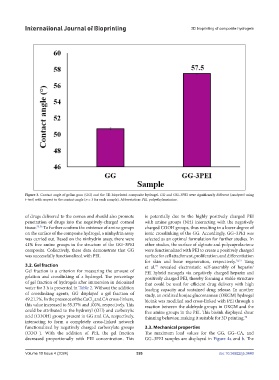Page 334 - IJB-10-4
P. 334
International Journal of Bioprinting 3D bioprinting of composite hydrogels
Figure 3. Contact angle of gellan gum (GG) and the 3D-bioprinted composite hydrogel. GG and GG–3PEI were significantly different (analyzed using
t-test) with respect to the contact angle (n = 3 for each sample). Abbreviation: PEI, polyethyleneimine.
of drugs delivered to the cornea and should also promote is potentially due to the highly positively charged PEI
penetration of drugs into the negatively-charged corneal with amine groups (NH) interacting with the negatively
tissue. 75,76 To further confirm the existence of amino groups charged COOH groups, thus resulting in a lower degree of
on the surface of the composite hydrogel, a ninhydrin assay ionic crosslinking of the GG. Accordingly, GG–3PEI was
was carried out. Based on the ninhydrin assay, there were selected as an optimal formulation for further studies. In
41% free amine groups in the structure of the GG–3PEI other studies, the surface of alginate and polycaprolactone
composite. Collectively, these data demonstrate that GG were functionalized with PEI to create a positively charged
was successfully functionalized with PEI. surface for cell attachment, proliferation, and differentiation
for skin and bone regeneration, respectively. 20,21 Tang
3.2. Gel fraction et al. revealed electrostatic self-assembly of heparin/
77
Gel fraction is a criterion for measuring the amount of PEI hybrid nanogels via negatively charged heparin and
gelation and crosslinking of a hydrogel. The percentage positively charged PEI, thereby forming a stable structure
of gel fraction of hydrogels after immersion in deionized that could be used for efficient drug delivery with high
water for 3 h is presented in Table 2. Without the addition loading capacity and sustained drug release. In another
of crosslinking agents, GG displayed a gel fraction of study, an oxidized konjac glucomannan (OKGM) hydrogel
49.21.7%. In the presence of the CaCl and CA cross-linkers, bioink was modified and cross-linked with PEI through a
2
this value increased to 55.37% and 100%, respectively. This reaction between the aldehyde groups in OKGM and the
could be attributed to the hydroxyl (OH) and carboxylic free amine groups in the PEI. This bioink displayed shear
acid (COOH) groups present in GG and CA, respectively, thinning behavior, making it suitable for 3D printing. 78
interacting to form a completely cross-linked network
functionalized by negatively charged carboxylate groups 3.3. Mechanical properties
(COO ). With the addition of PEI, the gel fraction The maximum load values for the GG, GG–CA, and
—
decreased proportionally with PEI concentration. This GG–3PEI samples are displayed in Figure 4a and b. The
Volume 10 Issue 4 (2024) 326 doi: 10.36922/ijb.3440

